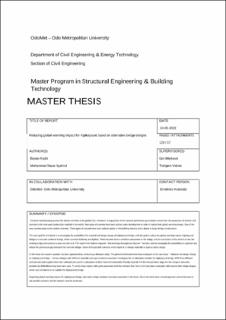Reducing global warming impact for Kjøkøysund based on alternative bridge designs
Master thesis
Published version
Permanent lenke
https://hdl.handle.net/11250/3022789Utgivelsesdato
2022Metadata
Vis full innførselSamlinger
Sammendrag
Concrete manufacturing account for almost one tenth of the global CO2- emissions. A big portion of the concrete greenhouse gas emission comes from the production of cement, still concrete is the most used construction material in the world. New types of concrete have been and are under development in order to reduce their global warming impact. One of the new concrete types is low carbon concretes. These types of concrete have been utilized widely in the building industry but is absent in larger bridge constructions.
The main goal for this thesis is to investigate the possibilities for material and design change of Kjøkøysund bridge, with the goal to reduce the global warming impact. Kjøkøysund bridge is a concrete cantilever bridge, which connects Kråkerøy and Kjøkøy. There has been done a condition assessment on the bridge, and the conclusion of this work is to tear the existing bridge and construct a new one next to it. The report from Statens Vegvesen “Bærekraftige betongkonstruksjoner” has been used to investigate the possibilities to optimize and reduce the greenhouse gas emissions for concrete bridges. Some of the possible solutions in the report is to change materials or superstructure design.
In this thesis the research question has been approached by conducting a literature study. The gathered information has been employed on the case study ‘’ Material and design change on Kjøkøysund bridge’’. Various designs with different materials and superstructures have been investigated for an alternative solution for Kjøkøysund bridge. EPD from different concrete and steel supplier have been collected and used in a calculation to find most environmentally friendly material. For the transportation stage A4, the transport calculator provided by Østfoldforskning have been used. To verify these results a life cycle assessment with the software One Click LCA have been conducted, with several other bridge designs which was considered to be suitable for Kjøkøysund bridge.
Regarding global warming impact for Kjøkøysund bridge, alternative bridge solutions have been presented in this thesis. Since this thesis have a broad approach and not focused on one specific solutions, further research must be conducted.
